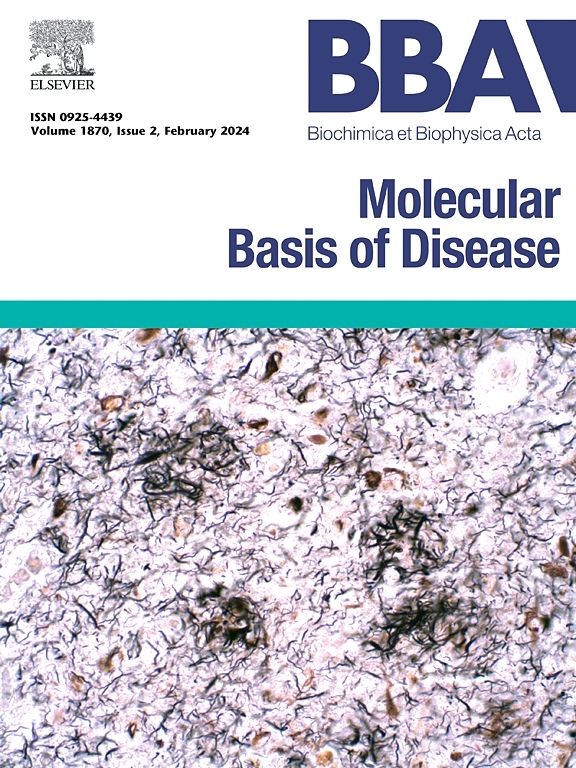PGC-1α role in rescuing ferroptosis in cerebral ischemia/reperfusion injury through promoting mitochondrial biogenesis and UCP2 expression
IF 4.2
2区 生物学
Q2 BIOCHEMISTRY & MOLECULAR BIOLOGY
Biochimica et biophysica acta. Molecular basis of disease
Pub Date : 2025-04-26
DOI:10.1016/j.bbadis.2025.167874
引用次数: 0
Abstract
Cerebral ischemia/reperfusion injury (CIRI) is a critical factor leading to adverse outcomes in acute ischemic stroke with reperfusion therapy. The occurrence of CIRI involves several cell death pathways, such as ferroptosis. Peroxisome proliferator-activated receptor-γ coactivator 1α (PGC-1α) a vital role in mitochondrial biogenesis and induces several crucial reactive oxygen species (ROS) detoxifying enzymes. Nonetheless, the role of activated PGC-1α in CIRI is still unclear. In this research, we utilized a PGC-1α agonist (ZLN005) in both in vitro and in vivo models of CIRI and found that ZLN005 ameliorates neurologic deficits, reduces infarct volume, and inhibits neuronal ferroptosis in CIRI. Furthermore, CIRI led to a decrease in neuronal mitochondrial quantity and downregulation of uncoupling protein 2 (UCP2) expression. Treatment with ZLN005 activated PGC-1α, promoted neuronal mitochondrial biogenesis, and upregulated UCP2 expression, thereby reducing mitochondrial oxidative stress. The application of the mitochondria-targeted antioxidant Mito-TEMPO inhibited ferroptosis, while UCP2 silencing induced mitochondrial oxidative stress and weakened ZLN005 inhibitory effect of ferroptosis, confirming the dependency of ferroptosis on mitochondrial oxidative stress in CIRI. According to these findings, targeting PGC-1α may offer an effective therapeutic strategy for CIRI by regulating mitochondrial homeostasis and protecting neurons from ferroptotic damage.

PGC-1α通过促进线粒体生物发生和UCP2表达在脑缺血再灌注损伤中挽救铁下垂中的作用
脑缺血/再灌注损伤(CIRI)是导致急性缺血性卒中再灌注治疗不良结局的关键因素。CIRI的发生涉及多种细胞死亡途径,如铁下垂。过氧化物酶体增殖体激活受体-γ共激活因子1α (PGC-1α)在线粒体生物发生中起重要作用,并诱导几种关键的活性氧(ROS)解毒酶。尽管如此,活化的PGC-1α在CIRI中的作用仍不清楚。在这项研究中,我们在体外和体内CIRI模型中使用了PGC-1α激动剂(ZLN005),发现ZLN005改善了CIRI的神经功能缺陷,减少了梗死体积,并抑制了神经元铁凋亡。此外,CIRI导致神经元线粒体数量减少,解偶联蛋白2 (uncoupling protein 2, UCP2)表达下调。ZLN005激活PGC-1α,促进神经元线粒体生物发生,上调UCP2表达,从而减轻线粒体氧化应激。应用线粒体靶向抗氧化剂Mito-TEMPO抑制铁下垂,而UCP2沉默诱导线粒体氧化应激,减弱ZLN005对铁下垂的抑制作用,证实了CIRI中铁下垂对线粒体氧化应激的依赖性。根据这些发现,靶向PGC-1α可能通过调节线粒体稳态和保护神经元免受铁致损伤为CIRI提供有效的治疗策略。
本文章由计算机程序翻译,如有差异,请以英文原文为准。
求助全文
约1分钟内获得全文
求助全文
来源期刊
CiteScore
12.30
自引率
0.00%
发文量
218
审稿时长
32 days
期刊介绍:
BBA Molecular Basis of Disease addresses the biochemistry and molecular genetics of disease processes and models of human disease. This journal covers aspects of aging, cancer, metabolic-, neurological-, and immunological-based disease. Manuscripts focused on using animal models to elucidate biochemical and mechanistic insight in each of these conditions, are particularly encouraged. Manuscripts should emphasize the underlying mechanisms of disease pathways and provide novel contributions to the understanding and/or treatment of these disorders. Highly descriptive and method development submissions may be declined without full review. The submission of uninvited reviews to BBA - Molecular Basis of Disease is strongly discouraged, and any such uninvited review should be accompanied by a coverletter outlining the compelling reasons why the review should be considered.

 求助内容:
求助内容: 应助结果提醒方式:
应助结果提醒方式:


